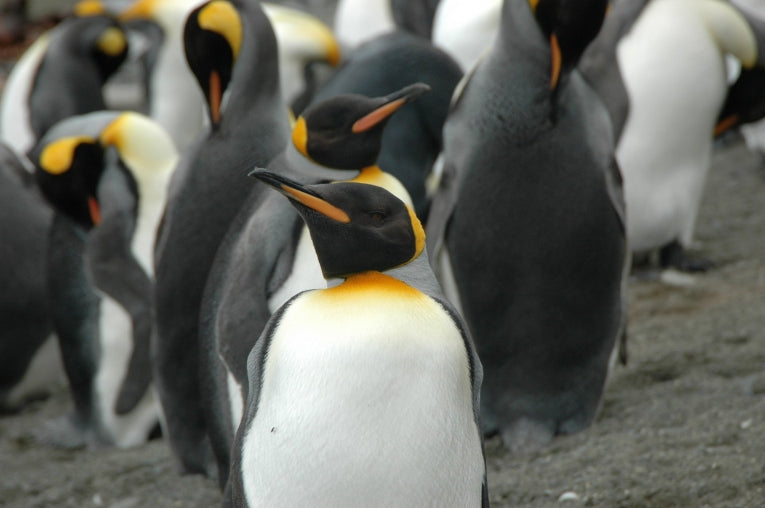Halfway house, between Australia and Antarctica, Macquarie Island was used as a seal and penguin exploitation site for their "blubber." Fortunately the two huge original colonies of King Penguins ended up as a single tiny surviving colony due to the efforts of conservationists. The King Penguin (Aptenodytes patagonicus) is a great survivor, unlike some species on Macquarie that become extinct quickly after sealers took over the island in the 19th century.
After at least three spp. of fur seal, elephant seals were taken and then an industry using the King Penguins in a "steam digester." Some remnants of this industry can still be seen in parts of the island. Fortunately, there was too much blood in the mix for fermenting to be successful in this industry, so Royal Penguins were attacked instead. This penguin oil industry confuses the modern ideas we have of "blubber" but although less profitable than seals, penguin oil produced half a litre per penguin. After 1919, petroleum oil became commercially successful and the island reverted to a wild environment after 109 years of total exploitation.
Cousin of the huge Emperor, the King Penguin is a magnificent diver and has impressed us for much more than its oil. Even distant Edinburgh Zoo has them as their mascot. The dive record is 343 metres, which for a 90cm bird at 16kg maximum, is remarkable. They were actually exterminated on the Falklands and Heard Island, being circumpolar, but with a 9.7 % growth in worldwide population, they have even managed to re-colonise there. On Macquarie, the 1930 population of 3,400 animals has recovered now to 70,000, with new colonies now dotted around the east coast.( One colony is growing at a rate of 66% pa.)

Digesters used to harvest penguin oil on Macquarie Island; Credit: Shutterstock
Tim Heupink, John van den Hoff, and David Lambert present the penguins in the Royal Society Journal, Biology Letters. They work from Griffiths University, in Nathan, Australia and the Australian Antarctic Division, The paper explains how ancient DNA from sub-fossil sites, including the west coast, can be used to assess how the modern recovery compares with pre-human populations and the drastic anthropogenic pressure of the 19th century. Samples from 17 natural carcasses' feet and 300mg of sub-fossil bone shavings were extracted and purified before expert mitochondrial genome investigation produced the data. Radiocarbon-dating showed up the >1000 BP date of the sub-fossils taken.

Credit: © Tim H. Heupink. This is Tim showing the semi-fossils from Mcquarie Island
Both ancient and modern populations show great genetic diversity. No single ancestral type exists. Instead, the great population bottleneck (presumably around1930) has left no trace of shared haplotypes (genotypes) between the old and the new.

The King Penguin bottleneck diagram; Credit: © Tim H. Heupink
The ancient population of the Isthmus was the group that were made extinct, leaving only the severely depleted Lusitania Bay colony with little genetic diversity. The northern population probably came from the remnants of the Lusitania Bay group. The ancient population from this area is quite closely related to the present population and it shows a similar genetic diversity. This study shows that the King Penguins in this area have recovered their original genetic diversity in only 80 years since their mass exploitation for blubber oil. Comparing ancient and modern DNA makes it possible to investigate the success of conservation measures. In this case, putting an end to exploiting King Penguins and controlling fishing and pests have clearly helped them to recover so quickly."
And the final news on Macquarie - the endemic Royal Penguins show every sign of a similar recovery to that of the Kings.










